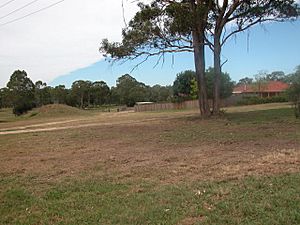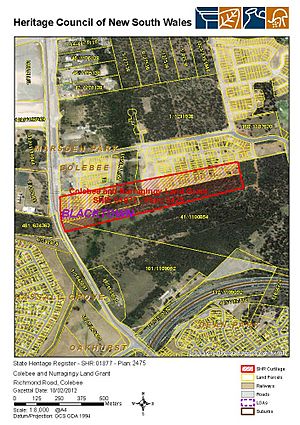Colebee and Nurragingy Land Grant facts for kids
Quick facts for kids Colebee and Nurragingy Land Grant |
|
|---|---|

Richmond Road part of the site
|
|
| Location | Richmond Road, Colebee, City of Blacktown, Sydney, New South Wales, Australia |
| Owner | Roads and Maritime Services |
| Official name: Colebee and Nurragingy Land Grant; Colebee and Nurragingy's Land Grant; Colebee Release Area; 773; 777; 783 Richmond Road | |
| Type | state heritage (archaeological-terrestrial) |
| Designated | 10 February 2012 |
| Reference no. | 1877 |
| Type | Post-contact Site |
| Category | Aboriginal |
| Lua error in Module:Location_map at line 420: attempt to index field 'wikibase' (a nil value). | |
The Colebee and Nurragingy Land Grant is a special historical site in Colebee, Sydney, Australia. It was once a farm located on Richmond Road. This land is important because it was the first land grant ever given to Aboriginal people in Australia. It is now owned by the Roads and Maritime Services and is listed on the New South Wales State Heritage Register as a protected site.
Contents
The Story of the Colebee and Nurragingy Land Grant
To understand the Colebee/Nurragingy Land Grant, we need to look at the early days of European settlement in Sydney. When British settlers arrived, they quickly expanded their farms westwards. These new farms took over traditional Aboriginal hunting grounds. This led to conflict between the two groups, especially during times of drought.
Early Conflicts and a Special Grant
Between 1814 and 1816, a drought made things worse. Aboriginal people found their usual food sources gone. They began to use the settlers' crops and animals instead. The European settlers saw this as theft, which led to more violence.
In April 1816, Governor Macquarie decided to act. He sent soldiers from Sydney to different areas to stop the violence. Some Aboriginal guides, including Colebee and Nurragingy, helped these soldiers.
After this time, Governor Macquarie gave Nurragingy a special breastplate. It said "Chief of the South Creek Tribe." To thank them for their help, Macquarie also gave Colebee and Nurragingy 30 acres of land together. This was a very important moment. It was the first time Aboriginal people in Australia were given land by the government.
The land grant was officially recorded in 1819, but only in Colebee's name. Colebee did not stay on the land for long. However, Nurragingy lived there, growing crops and raising animals.
A Place Chosen by Aboriginal People
The location of this land grant was special. Nurragingy chose it because it was on land that belonged to his own clan. The area also had important sites, like "Iron Bark Range." This was a high camping spot that was safe from floods. It was also a source of silcrete, a type of stone used for tools.
This area became a central place for Aboriginal life during the early years of colonisation.
The Locke Family and Later Years
After Colebee and Nurragingy passed away, the land was claimed by Nurragingy's sons and Colebee's younger sister, Maria Locke. Maria had studied at the Parramatta Native Institution. In 1824, she married Robert Locke, a European convict.
Since the land grant was only in Colebee's name, it passed to Maria. Maria and Robert, along with their ten children, moved onto the land. They later bought another 30-acre grant nearby. Maria Locke passed away in 1878. The 60 acres of land were then divided among her nine surviving children.
The Locke family lived on the property until about 1917. At that time, the Aboriginal Protection Board acquired the land. The Board later sold the land after World War II. In the 1970s, a member of the Locke family, Walter Locke, tried to get the land back. However, he was told it was not possible because the family had left the land. Some people felt this was wrong.
Later, parts of the land were bought by the government for road widening projects.
What Does the Site Look Like Today?
Today, the Colebee/Nurragingy Land Grant is mostly undeveloped rural land. It has Richmond Road on its western side. The land still has a rural feel, even though some houses have been built along Richmond Road.
A creek called Bells Creek runs through the middle of the land. The eastern part of the site and the areas along Bells Creek still have natural plants and trees. The western part, closer to Richmond Road, has been cleared more.
The creek and its surroundings help the land keep some of its original natural feel.
What Can We Learn from the Site?
Experts have looked at the land to see if there are any historical remains. They believe the area might contain "Potential Archaeological Deposits" (PAD). This means there could be hidden evidence of past life underground.
Historically, records show that the following things were built on the land grant:
- a hut made of bark and logs with a chimney
- gardens
- fences
- small buildings like sheds and animal pens
- vegetable patches and crops
Experts also think there might be evidence of Aboriginal camps from 1819 to 1823, and even from before that time. Finding these things could help us understand more about how people lived on the land long ago.
Why is This Place Important?
The Colebee/Nurragingy Land Grant is very important for its history, social meaning, and cultural value. It was the first land grant ever given to Aboriginal people in Australia. This makes it a landmark in the history of how Aboriginal and non-Aboriginal people interacted.
For Aboriginal people, this site is a symbol of their strength and their lasting connection to the land.
A Landmark in History
This land grant is a key part of the history between Aboriginal and non-Aboriginal people in Australia. It shows the first attempts by Aboriginal people to live within European society while keeping their own independence.
The grant also shows an early government idea that Aboriginal people did not own their traditional lands. Instead, they would be given land by the government. In a way, this early policy connects to the later fight for Aboriginal land rights in Australia.
The Colebee/Nurragingy Land Grant is also linked to the nearby Blacktown Native Institution. Many Aboriginal families camped near the grant to be close to their children who were in the institution. This shows how parents refused to be separated from their children. The land grant is a symbol of how Aboriginal traditions, family ties, and connection to place continued.
Important People Connected to the Site
The Colebee/Nurragingy Land Grant is strongly connected to Colebee and Nurragingy. They were two very important Aboriginal figures in early colonial Sydney. It is also linked to Governor Lachlan Macquarie, who gave them the land in 1816. The site is part of the "Black Town" area, where a strong Aboriginal community formed and still exists today.
Colebee and Nurragingy were the first Aboriginal people to be granted land. Nurragingy chose the land because it was in his traditional clan area. This settlement became a key place for Aboriginal life in the early colonial period.
The land grant also shows Governor Macquarie's policies towards Indigenous people. It reflects his and Mrs. Macquarie's care for the Aboriginal people of the colony. They believed Aboriginal people should be kept separate from any negative influences from European society.
The site is also strongly connected to the Locke family. Maria Locke was seen as a "success" by Europeans from the Parramatta Native Institution. Her marriage to Robert Locke in 1824 was the first official marriage between a European and an Aboriginal woman. After Nurragingy died, Maria successfully asked Governor Darling for the Colebee/Nurragingy Land Grant. The Locke family then lived on the land.
A Special Place for the Aboriginal Community
For the Aboriginal community, this site represents their survival after colonisation. It shows how they continued despite the harm caused by losing their land. The site connects them to the early Aboriginal settlement at Blacktown and to Colebee and Nurragingy.
What Can Archaeology Tell Us?
The site has the potential to hold archaeological remains. These could give us information that we cannot find anywhere else. They could tell us about how Aboriginal people used the land during the early contact period.
Archaeological finds could help us understand where Colebee, Nurragingy, and their families lived on the land. They might also show where others lived there during that time. Possible remains include parts of the bark and log hut, gardens, fences, sheds, animal pens, and old vegetable patches. There is also a chance to find evidence of Aboriginal camps and burials from before and during the early colonial period.
A Rare and Unique Place
The Colebee/Nurragingy Land Grant is unique because it was the first land grant given to Aboriginal people in Australia's history. It is also rare because it has a direct link to important Aboriginal historical figures like Colebee and Nurragingy.


